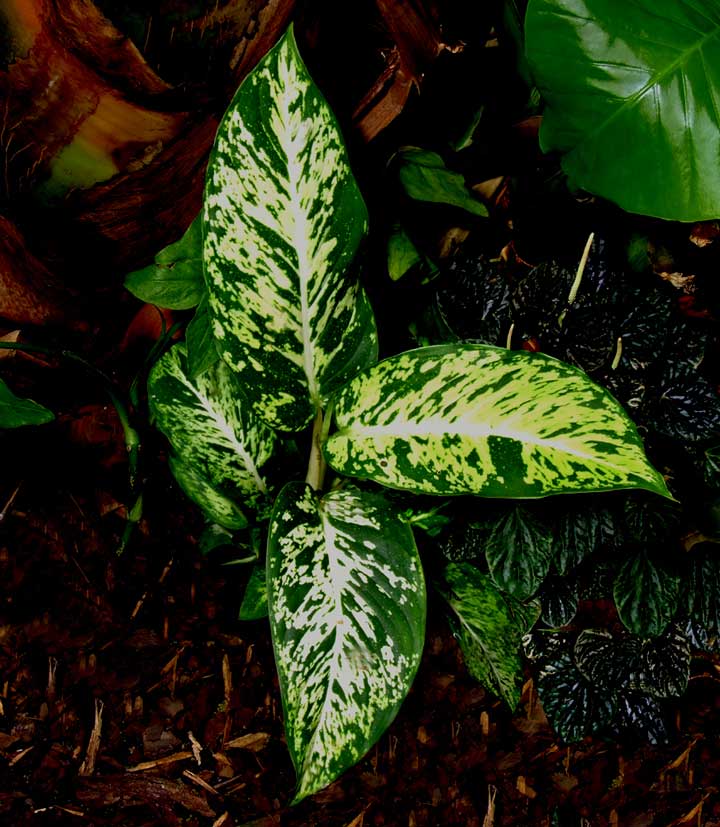![]()
Aroids and other genera in the Collection
Take the Tour Now?
Orchids
The
Exotic Rainforest
Plants in
the Exotic Rainforest Collection
Images on this website are copyright protected. Contact us before
attempting to reuse.
Dieffenbachia
seguine
(Jacq.) Schott
A hybrid form

A hybrid form
Spotted Dumbcane, Leopard lily, Galatea
Sometimes sold as Dieffenbachia "Sparkles"
Although politically incorrect: "Dumb Cane" for a very good reason!
Dieffenbachia species are known as "Dumb Cane" for a
really good reason! If you take a bite of a leaf your mouth will go
numb! You will loose your voice. It could make you very ill!
It could end up putting you in a hospital. And at least one verified
case of death has been confirmed. So don't eat the plant!
But the problem with this species is quite unique due a combination of
chemical reactions, only one of which is calcium oxalate crystals.
If
you are interested in the effects of calcium oxalate read this link:
Calcium
oxalate cyrstals.
Dieffenbachia species are very commonly sold at many nursery centers. You can even them at discount stores. I found this Dieffenbachia seguine as a very young plant at a local discount store for just a couple of dollars. In three months it has more than tripled its size and is on its way to becoming a relatively tall and interesting plant.
In fact, Dieffenbachia can easily grow (depending on the species) to 6 to 10 feet in their native range of Central and South America through Brazil. The plant prefers bright to medium light and high humidity due to its normal habit of growing in tropical rain forests. It will grow in almost full sunlight once acclimated, but for best growth give it a bit of subdued light. Dieffenbachia species are quite easy to grow and are commonly kept as houseplants. The major problem with keeping them in your home is inadequate light and humidity. As a result, they often do not survive.
Many have very decorative leaves such as the splotchy effect seen in D. seguine. The color patterns of different species can present a very pleasing effect in interior designs provided you give them adequate light. Although some magazine texts recommend not watering the plant until it almost completely dries out you must remember this is a tropical rain forest plant. The plant should be grown in fast draining very loose and well aerated soil that can be kept damp but not soggy. A mixture of good potting soil, peat, Perlite and a helping of orchid bark will create a nice soil mixture (known as a "jungle mix") the plant will grow in well.
Dieffenbachia species like a consistently warm indoor or outdoor environment away from cool drafts. However you'll get more dramatic growth in a greenhouse. Temperatures of 65 to 85 F will suffice nicely, but the plant does not like temperatures much below 60 F. Dieffenbachia are an herb and a member of the Aroid family. Reportedly they do not often produce an inflorescence in captivity. They have been imported into many Pacific islands and in Fiji often become a "weed" by taking over roadsides and coconut plantations.
Some pharmaceutical companies are testing the plant and have learned it has a contraceptive effect, at least in female rats! Since many people remind me frequently that at least 2/3rds of the plants in the Exotic Rainforest atrium are "deadly poison" I should caution again the sap of all Dieffenbachia species are an irritant. It can cause an unpleasant numbness and swelling in the throat if eaten.
My advice? Don't chew or eat your plants!
Join the International Aroid Society: http://www.exoticrainforest.com/Join%20IAS.html